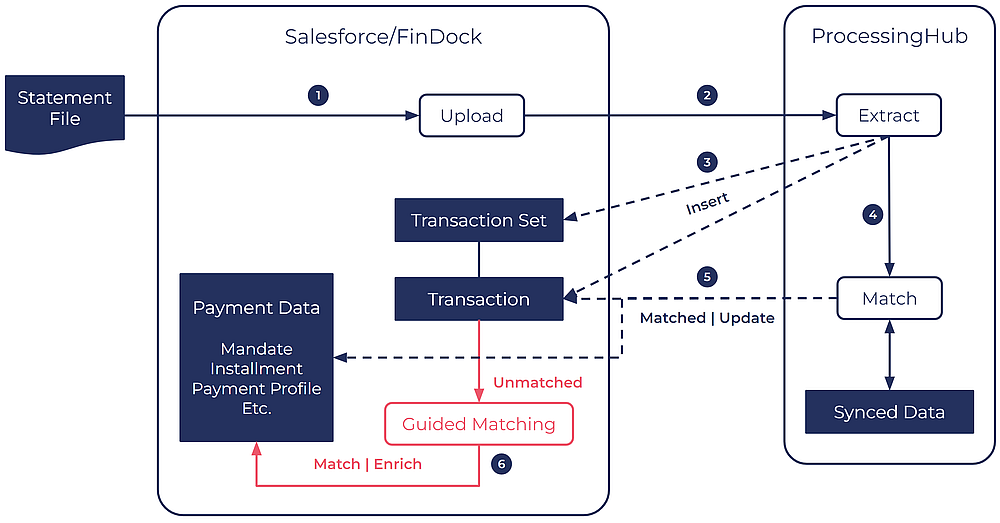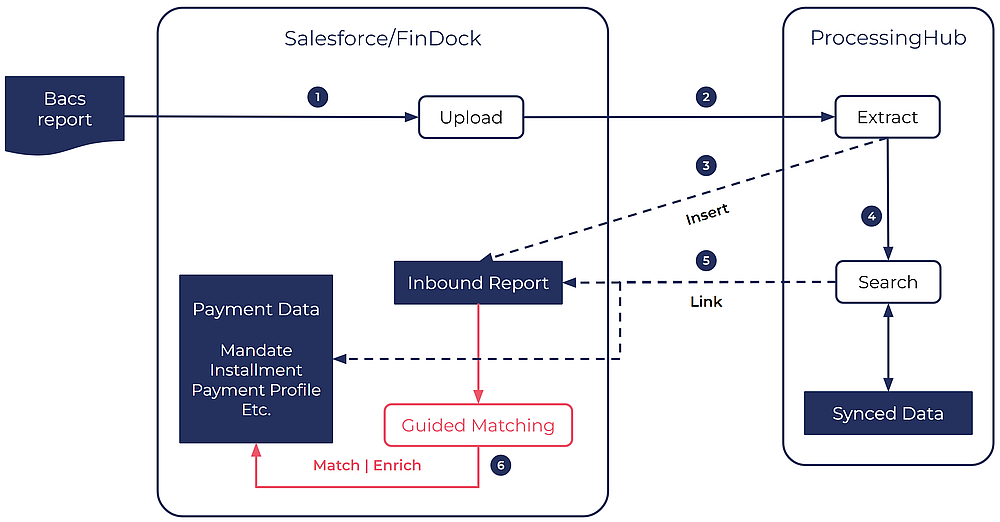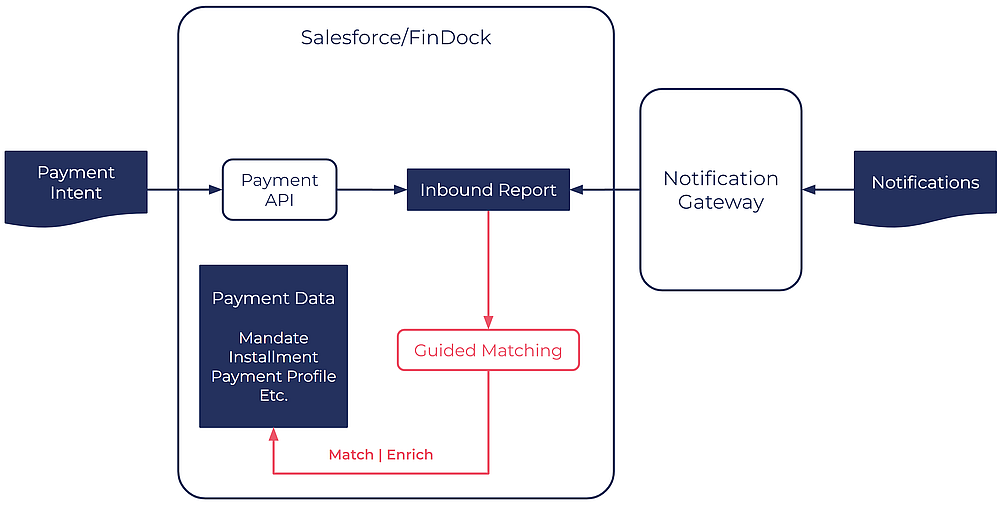What is Guided Matching?
Guided Matching is a powerful toolset for reconciling incoming payment data. With Guided Matching you can:
- Increase automated matching percentage
- Reduce time to process inbound payment data
- Speed up manual actions through guided steps
- Improve automation and create personalized follow-up journeys
- Gain insights for improving payment processing
Guided Matching helps process incoming payment data through:
- Enrichment: The process of adding more information to a Transaction or Inbound Report record.
- Matching: The process of finding the corresponding installment for a Transaction or Inbound Report record.
- Guided Review: A matching state where the record needs manual user actions before processing can continue.
Check out our self-paced Guided Matching course for additional guidance and hands-on exercises.
File-based transactions
Based on the file type, Guided Matching extends the automated matching on ProcessingHub or carries out all matching logic.
Files that are transformed into transaction sets with linked transactions typically use the following reconciliation process where Guided Matching comes after the automated matching on ProcessingHub.

- The file is uploaded to the Chatter group designated for file exchanges.
- ProcessingHub picks up the file from Chatter and extracts the contents.
- ProcessingHub inserts new Transaction Set and Transaction records, and based on the target or file type, attaches a Guided Matching setup to the set.
- ProcessingHub carries out automatic matching of transactions based on payment reference and end-to-end Id.
- Automated matching results are used to update transactions on Salesforce. The transaction status may be set to Pending and/or Processing states before Guided Matching completes handling the related transaction set.
- Guided Matching is used to complete the reconciliation process for unmatched records and enrich matched results.
File-based inbound reports
For files that are transformed into inbound reports, Guided Matching does more of the reconciliation work. Some matching may still be done on ProcessingHub, but in other cases, such as with Bacs Direct Debit reports illustrated, below, ProcessingHub takes minimal action on the extracted data.

- The file is uploaded to the Chatter group designated for file exchanges.
- ProcessingHub picks up the file from Chatter and extracts entries into Inbound Report records.
- The new inbound reports are inserted to Salesforce.
- ProcessingHub searches for existing mandate references used in the new inbound reports.
- Matched mandates are linked to the inbound reports.
- Based on the inbound report Type and Sub-Type, Guided Matching completes the reconciliation process.
Online payment matching
Online payment reconciliation is driven exclusively by Guided Matching. From the initial payment intent message to the numerous processing notifications from PSPs, all are captured as inbound reports that go through Guided Matching.

For more details about Guiding Matching for online payments, see processing and reconciling online payments .
Guided Matching phases
Guided Matching actions are carried out on Transaction or Inbound Report records. While finding and matching records is the main goal, there are several phases of the process.
Enrichment
Enrichment adds more data to the transactions and inbound reports. The only practical limit is that the field type of the returned field must be the same as the transaction field type on the record. For instance, you cannot enrich an amount with text.
The main enrichment methods are:
- Extract a value from a field on the record to add to another field using regular expressions. This is commonly used with raw message entries which have additional content about the payer transaction, or, for example, extracting a campaign code from the payment reference.
- Query Salesforce using a field as the query parameter, such as querying Campaign using the just extracted campaign code.
- Add a constant value to a field, like adding a default campaign code if there was no code included in the incoming payment data.
Find and matching
Matching is a special form of enrichment. The goal is to find the correct contact or account, payment profile and installment related to the Transaction or Inbound Report record.
Create and update
After the transaction or inbound report is fully enriched, all that data can be used to modify Salesforce data by creating or updating records.
Process Installment
The last matching step is always to handle update to the matched installment. In this step, FinDock uses internal business logic to update installment amounts, states and create Payment records.
Guided Review
Sometimes automatic matching fails and manual intervention is needed. In this case, the record is put into Guided Review. Using the Guided Review component on the record detail page, a user can follow the prompts to provide additional input and continue the Guided Matching process by clicking Retry & Continue.
Rule builder and components
Guided Matching comes with a rule builder to create or enhance the matching setup.
Guided Matching also includes with the following Lightning components:
- Guided Review: If Guided Matching does not have enough information to automatically process a Transaction or Inbound Report record, the user is asked for input in the Guided Review component. What makes Guided Matching special is that the matching questions are very specific to where matching is in the process and to data in the database.
- Guided Matching Progress. This shows where matching is in the process and what the outcome was of completed rules. The exact same view of the rule execution plan shown in the builder design-time is also shown run-time in this component, providing context specific feedback on matching.
- Transaction Set Progress: This shows matching progress for all transactions related to the given transaction set.
Pre-shipped rules
For many types inbound payment data, FinDock provides pre-shipped matching rules. These rules cover the essential reconciliation steps so that organizations need to add custom rules for their unique requirements. Often no changes need to be made to pre-shipped rules.
Some pre-shipped rules are managed and others are unmanaged. The unmanaged rules are inserted once on installation and can be modified.
Pre-shipped rules not managed by FinDock are installed once. They are not updated by FinDock as part of new releases.
Managed pre-shipped rules are part of a managed rule set. For these kinds of rules, only the reference to the rule is added to the org. The actual rule definition is part of one of the FinDock managed packages. These rules can be changed by FinDock in order to make sure that rules stay in line with standards, regulations and new developments.
Batch matching through Guided Matching
Guided Matching can be used for batch payment matching similar to ProcessingHub. This is handled through an initial Query rule in the given Guided Matching setup that checks if the inbound record has a File Reference value that matches the record Id of a PaymentHub file.
If a File Reference match is found, the batch evaluation proceeds by checking installment amounts. If the sum total amount of all installments linked to the matched ProcessingHub File record equals the amount of the reported transaction, batch matching completes by marking all linked installments as Collected and creating corresponding Payment records for the individual installment amounts.
If there is a discrepancy in the sum total amount of linked installments and the batch transaction amount, FinDock stops Guided Matching during validation and indicates the amounts do not match. At this point, manual intervention is needed. You either need to fix installment amounts or change the batch amount. Once the discrepancy is rectified, you can retry all Guided Matching rules to complete the matching.


